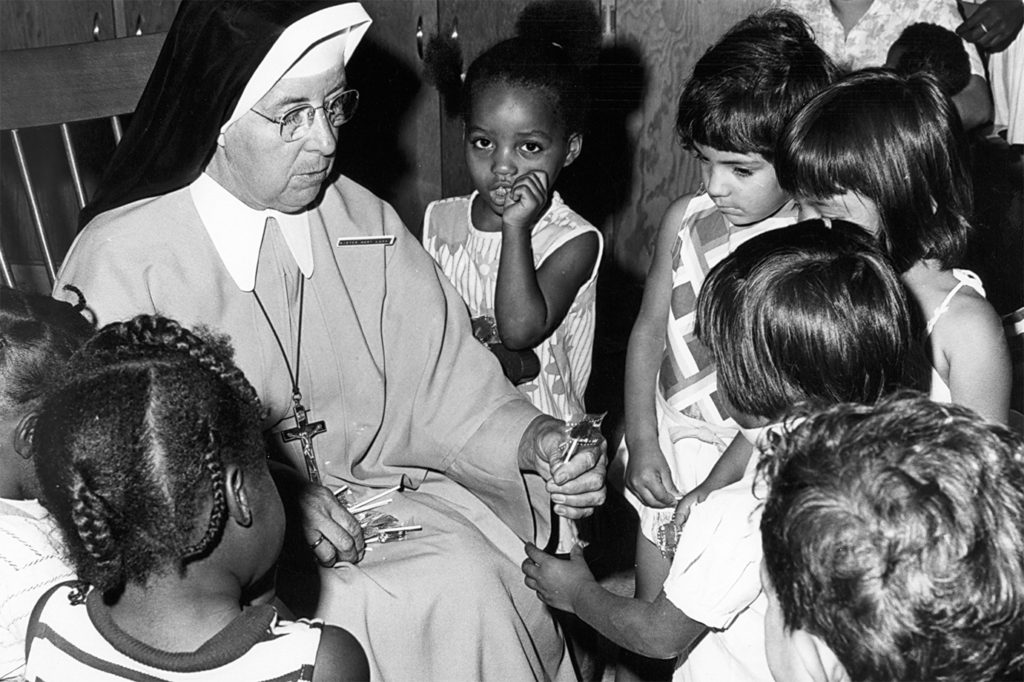
The story of the Diocese of Phoenix’s first half-century cannot be told without its Catholic schools, and the education system cannot be chronicled without the account of Arizona’s women religious — the sisters from over four dozen orders who taught thousands of students in those schools.
“The impact of religious sisters serving for the past 50 years in our diocese has been tremendous. While it’s difficult to quantify, I think it’s safe to say the outstanding tradition of academic and formative success our Catholic schools enjoy in this diocese and throughout the country is in large part directly related to the work of these inspirational educators,” said Catholic Schools Superintendent Harry Plummer shortly after the recent Night of Hope, the annual fundraising dinner for diocesan schools.
Bishop Thomas J. Olmsted, speaking at the Nov. 2 event at Xavier College Preparatory, said the religious women have offered “tremendous leadership” to Catholic schools over the years.
“They are creating a whole generation of leaders who are badly needed today; leaders who lead with humility and courage; both of which are badly needed in our public discourse today and in society as a whole.”
For their work, the religious women were collectively named this year’s Guardians of Hope honored at the event. The honor is but the latest chapter for the teaching nuns.
“Amazing things have taken place in Phoenix since I arrived in 1962 and Sr. Raphael in 1963,” Xavier President Sr. Joan Fitzgerald, BVM, told the audience, referring to Loreto Sister Raphael Quinn, IBVM, principal at Ss. Simon and Jude Cathedral School. “Tuition was $14 a month, and there was a $10 late fee. You could rent your books for $6 a year. Grade-school sisters were paid $35 a month, and high school sisters $70,” Sr. Joan recounted.
As the diocese grew, so did its schools, and in the midst of it all were the religious women.
“Once you established a parish, it was a given that you were going to open a school,” recalled Sr. Raphael in an interview with The Catholic Sun. She noted the Loreto sisters have been in Prescott since 1972 and opened St. Jerome School in Phoenix in 1965. At St. Jerome, as well as in other places, priests often recruited sisters to fill the schools as openings emerged.
“They would go all over the United States, and in our case, (founding pastor) Fr. (Paul) Smith came to Ireland to get sisters to staff the schools.”
Others had a somewhat shorter trip to Arizona. For example, Sr. Joan’s community, the Sisters of Charity of the Blessed Virgin Mary, came from the Midwest.
“Every school had a religious priest or sister as principal. Many times, the school was built before the permanent church,” she said.
Often, the gifts of school parents and families helped fuel construction.
“Our schools are beautiful institutions because of the generosity of the community and our parents,” added Sr. Joan.
“It was automatic. (Parents) wanted the kids to attend Catholic school. (Families) would make any sacrifice to send their kids,” Sr. Raphael explained. Today, tuition tax credits have helped foster giving to support families in need.
In recent years, the expanding diocese has built schools at an almost unmatched rate in the United States. Last year, the brand-new St. John Paul II High School — the first Catholic high school to serve the far West Valley, opened its doors under the leadership of the Dominican Sisters of St. Cecilia of Nashville and principal Sr. Mary Jordan Hoover.
Versatility often enabled sisters to fill many educational needs. That characteristic is important today.
“The mark of a good sister is her broad knowledge and the ability to use that across multi-disciplines. For some orders, the sisters are able to choose a particular discipline, sometimes the superiors, praying to the Holy Spirit, discern a particular need, and, according to the needs of the Church, the sisters will study an area they never planned for but discover they love, too,” explained Sr. Anthony Mary Diago, RSM, director of the diocesan Office of Consecrated Life.
Sisters were required in earlier days to devote as much attention as they could to larger groups of children. Sr. Raphael recalled class sizes of up to 50-55 students with enrollment at one point around 900. Students walked to class or rode their bikes, she said.
At Xavier, where Sr. Joan has taught at and then led the all-girls’ school, first as principal starting in 1974, and since 2016 as its first president, the 1960s approach included open classrooms and team teaching. Decades later, those methods have given way to smaller class sizes, printers, iPads, Google notebooks and the like.
But the mission remains the same.
The hallmarks are the Catholic identity and emphasis on an excellent education and “really challenging young women to be the best human being they can be, the best person — community-minded,” Sr. Joan explained. “They’ve been given a lot, and they’re responsible for giving back to the community.”
One example of what the Catholic education system has produced can be found at St. Agnes School in Phoenix, where Christine Tax has been principal for four years. Taught by the Loreto sisters at Ss. Simon and Jude, she graduated there in 1995, completing high school at St. Mary’s four years later before becoming a teacher in the diocese, a position she continued for 17 years. She said the example of women of faith in leadership, and in particular Sr. Raphael, played a big role in her career decisions.
“I always wanted to be a teacher. I never knew I wanted to be an administrator,” said Tax. “All the sisters there had a great joy for what they did every day. Our schools would not be here without them. They are really the founders of our schools. We rest on the shoulders of giants.”
Ambria Hammel contributed to this story.






